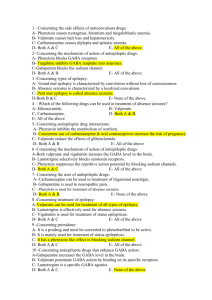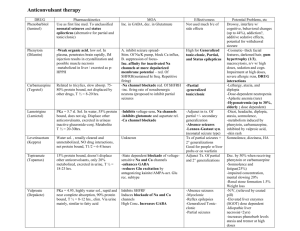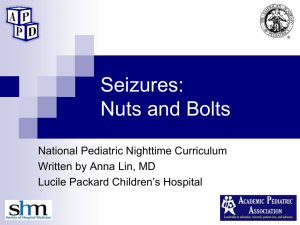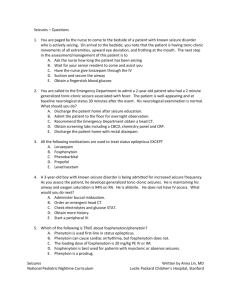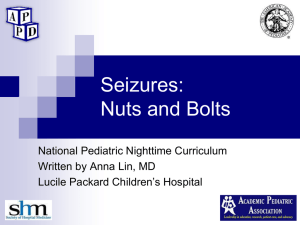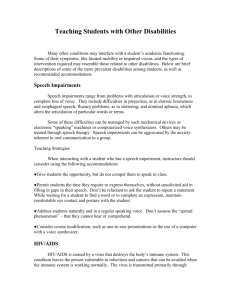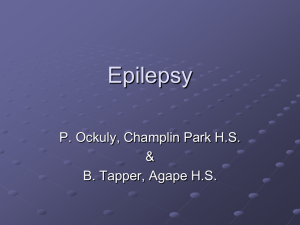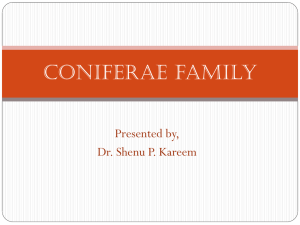Antiepileptics
advertisement
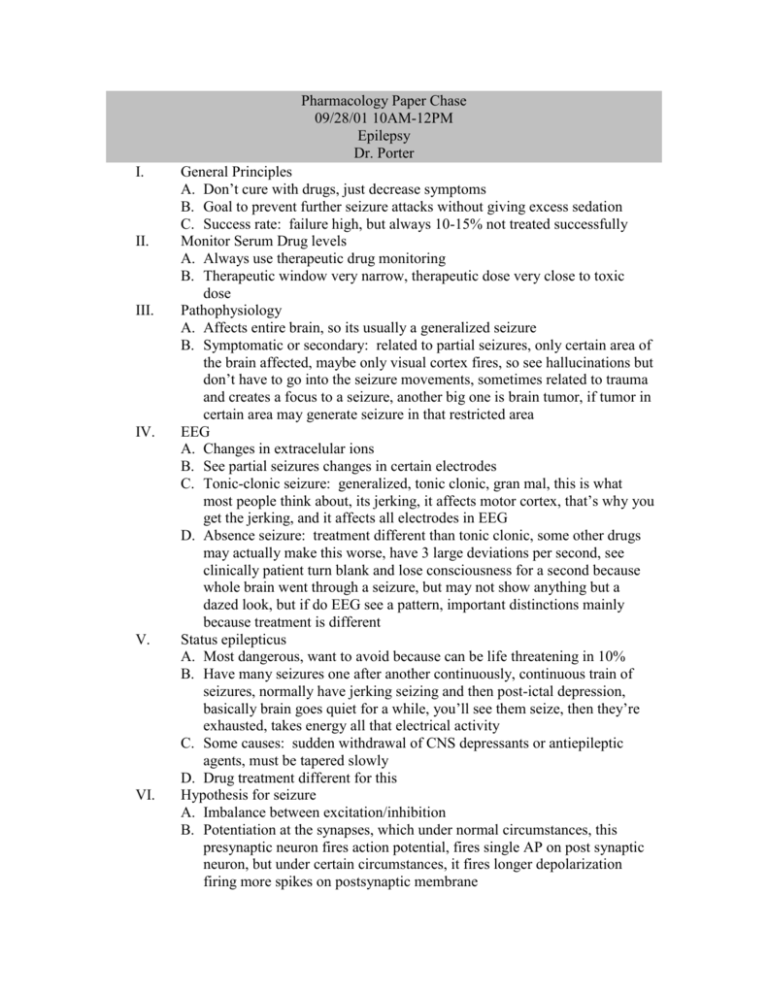
Pharmacology Paper Chase 09/28/01 10AM-12PM Epilepsy Dr. Porter I. II. III. IV. V. VI. General Principles A. Don’t cure with drugs, just decrease symptoms B. Goal to prevent further seizure attacks without giving excess sedation C. Success rate: failure high, but always 10-15% not treated successfully Monitor Serum Drug levels A. Always use therapeutic drug monitoring B. Therapeutic window very narrow, therapeutic dose very close to toxic dose Pathophysiology A. Affects entire brain, so its usually a generalized seizure B. Symptomatic or secondary: related to partial seizures, only certain area of the brain affected, maybe only visual cortex fires, so see hallucinations but don’t have to go into the seizure movements, sometimes related to trauma and creates a focus to a seizure, another big one is brain tumor, if tumor in certain area may generate seizure in that restricted area EEG A. Changes in extracelular ions B. See partial seizures changes in certain electrodes C. Tonic-clonic seizure: generalized, tonic clonic, gran mal, this is what most people think about, its jerking, it affects motor cortex, that’s why you get the jerking, and it affects all electrodes in EEG D. Absence seizure: treatment different than tonic clonic, some other drugs may actually make this worse, have 3 large deviations per second, see clinically patient turn blank and lose consciousness for a second because whole brain went through a seizure, but may not show anything but a dazed look, but if do EEG see a pattern, important distinctions mainly because treatment is different Status epilepticus A. Most dangerous, want to avoid because can be life threatening in 10% B. Have many seizures one after another continuously, continuous train of seizures, normally have jerking seizing and then post-ictal depression, basically brain goes quiet for a while, you’ll see them seize, then they’re exhausted, takes energy all that electrical activity C. Some causes: sudden withdrawal of CNS depressants or antiepileptic agents, must be tapered slowly D. Drug treatment different for this Hypothesis for seizure A. Imbalance between excitation/inhibition B. Potentiation at the synapses, which under normal circumstances, this presynaptic neuron fires action potential, fires single AP on post synaptic neuron, but under certain circumstances, it fires longer depolarization firing more spikes on postsynaptic membrane Pharmacology Paper Chase 09/28/01 10AM-12PM Epilepsy Dr. Porter VII. VIII. IX. X. XI. 2 C. Most drugs targeted at recovering this balance D. Mechanisms of antiepileptic drugs: block Na, Ca channels, or increase GABA inhibition (in future will block excitatory Glu receptors) Use dependent block of Na channel A. Resting condition have Na channel, activated and Na comes in to depolarize cell, then channel goes into inactivated stage and can’t reopen until resting stage which takes time, if increase time it takes to go back, you decrease it firing again B. Phenytoin, carbamazepine, lamotrigine > Phenobarbital, valproate, topiramate Block low-threshold T-type Ca channels A. Drugs used to treat tonic clonic are different from those that treat absent seizures B. These treat absent seizures C. Recording from thalamic neuron, which projects all over cortex, can excite lots of cortex all at once, so it’s a generalized seizure, they fire through Ca T-type channel, Na depolarizes cell then influx of Ca causing further depolarization, then they activate again and again, 3 times/second D. Under seizure condition, enhanced amounts of Na come in and get big bursts of spikes and get absent seizure E. Think about ethosuximide, and dimethadione (not used as often) Increase GABAergic inhibition A. If too much excitation, increase inhibition, bring it back into balance B. Newer drugs come out to work on the MOA C. Direct acting 1. Bind to GABA receptor, like Phenobarbital 2. If look at single gaba channel, they are closed/open, if add Phenobarbital, it alters the channel structure and have longer open times 3. BDZ bind to different site and frequency of channel opening increases, so get more influx of Cl more hyperpolarization more inhibition D. Indirect acting: enhance available amount of GABA, don’t act directly on GABA receptor, tiagabine and vigabatrin (enzyme breaks down GABA is GABA T or GABA transaminase, and vigabatrin inhibits GABA T) Drugs for partial and generalized tonic clonic seizures A. Use-dependent Na blockers B. Increase GABA Hydantoins: Phenytoin (Dilantin) A. Blocks Na channels B. Therapeutic index so narrow, be cautious with switching between generic drugs, the 1st pass effects may effect different generic drugs differently, and can saturate those enzymes which means it goes to zero order kinetics (phenytoin has possibility of becoming zero order kinetics) C. Certain percent of population have fast metabolizing enzymes in liver, so giving same dose, one patient will have higher concentration than another, Pharmacology Paper Chase 09/28/01 10AM-12PM Epilepsy Dr. Porter 3 we can’t use the same dose on all patients, so use therapeutic drug monitoring D. Toxicity 1. Ataxia: walks around like a drunk 2. Diplopia: bad if driving or using heavy machinery 3. Nystagmus: rolling of eyes 4. Drowsiness: don’t cause as much as other agents E. Chronic toxicity 1. Gingival hyperplasia: gums grow over the teeth, its not something life threatening, people don’t want to look that way 2. Coarsening of the facial features 3. Megaloblastic anemia XII. Teratogenic: Phenytoin: fetal hydantoin syndrome: birth defect in 10% pregnant women, one of signs is spina bifida, you have exposure of the spinal cord, so if you are going to use phenytoin, at least give supplemental vitamin K and folic acid, because these birth defects largely due to folic acid deficiency, and hopefully can avoid complication, lots of drugs are given with folic acid just in case becomes pregnant XIII. Drug interactions A. Inhibitors: increases metabolization cyt p450 1. Cimetidine, lots of patients taking this without seeing physicians, so phenytoin levels could increase B. Inducers 1. CBZ, alcohol, Phenobarbital C. Phenobarbital can decrease the effectiveness of oral contraceptives, so may have to go to higher levels of contraceptives D. If add one drug will interfere with other drug, good with adjuncts because don’t interfere XIV. Absent seizures A. Can make absent seizures worse B. More detrimental in children with gingival hyperplasia because developing C. CBZ new DOC XV. CBZ A. Blocks Na channel B. Autoinduction: increases its own metabolism, initially give dose which may not work because its metabolizing quicker, may have to titrate up the dose until get therapeutic effect C. Adverse effects: very safe, similar to phenytoin, the ones highlighted from first aid of the boards, diplopia, ataxia, just like phenytoin no difference, blood discrasia, even though rare, so toxic, can cause agranulocytosis and aplastic anemia, very bad blood disorders, also hepatotoxicity very rare, something to keep in mind D. Therapeutic indications 1. Useful for trigeminal and glossopharyngeal neuralgia 2. Antimania: usually Li but also can use CBZ Pharmacology Paper Chase 09/28/01 10AM-12PM Epilepsy Dr. Porter XVI. XVII. XVIII. XIX. XX. XXI. XXII. 4 3. Therapeutic drug monitoring (TDM) 4. Phenytoin and carbamazepine may worsen absent seizures Lamotrigine (adjunct) A. Also blocks Na channel B. Adjunct: no P450 induction, can be added onto pheyntoin if phenytoin not working that well, and don’t have to worry about drug interactions C. Adverse effects: Steven-Johnson syn is life threatening rash first to third degree burns over skin, its very nasty, not necessarily dose dependent, its hypersensitivity reaction to drug, so if see some strange rash, think that it could be due to drug, particularly lamotrigine Topiramate (adjunt) A. Adjunct partial seizures: more likely to have failure with partial seizures, so need adjunct B. MOA: main one is blocking Na channel, but may also increase GABA, and block some Glu C. Adverse effects: sedation, most can cause sedation, by increasing inhibition, kidney stones, mental dulling, weight loss D. Phenytoin and CBZ because of E ability can decrease plasma levels E. FDA: new drug tested in rats and its effective, now want to treat humans, want to run clinical trials, you identify epileptic population, what if drug doesn’t work, are you going to risk treating with unknown drug alone, or give it with known drug and see if it works Other drugs that treat tonic clonic and increase GABA neurotranmission Barbiturates: Phenobarbital and primidone (PEMA) A. PEMA will have same effect as phenobarb because its metabolized to phenobarb, but will have longer half life B. Induces p450 C. Sudden withdraw get status epilepticus: most likely decreased number of GABA receptors because have increased GABA neutrotransmission, and when stop, the balance of excitation is woah, and induce seizures D. TDM: for all antiepileptics that affect cytp450 BDZ A. Diazepam B. MOA: GABA inh C. Adverse: sedation, tolerance develops, dependence, not good to develop tolerance especially in chronic conditions that require constant therapy D. Page out of order, pages should be 249, 251, 250 E. Indications: status epilepticus GABA analog: gabapentin (adjunct) A. Worked great, works with GABA, but MOA unknown, so its adjunct B. No induction of hepatic enzymes, so very popular, very safe, top 200 drugs prescribed C. Adverse effects: sedation, movement disorders Tiagabine (adjunct) A. GABA inhibitor B. Very safe Pharmacology Paper Chase 09/28/01 10AM-12PM Epilepsy Dr. Porter 5 C. Not alter plasma levels of other antiepileptics XXIII. Vigabatrin (adjunct) A. Inhibits GABA transaminase: inhibits GABA breakdown B. Adverse effects: visual field deficits C. Indications: West’s syndrome (infantile spasms) XXIV. Drugs for generalized absence seizures A. Blocks T-type Ca channels: ethosuximide B. Valproic acid XXV. Ethosuximide A. DOC B. Not interfere with phenytoin, because if you have absent seizures you shouldn’t be using phenytoin anyways C. TDM D. Adverse effects 1. Trimethadione initially used for absent seizures, so no longer use trimethadione and use ethosux 2. GI distress, lethargy and fatigue, headache E. Drug interactions 1. Valproic acid: inhibits ethosux metab XXVI. Trimethadione (on page 250 starting with adverse effects) A. Due to toxicity, only used for patients who can’t be treated with ethosuximide or valproic acid B. Blood dyscrasias, photophobia (hemeralopia), sedation, dermatitis, hepatitis, nephrosis, hematological reactions are sometimes fatal XXVII. Valproic acid A. Absence seizures especially in adults B. Less useful in children because causes hepatotoxicity in children C. Unusual and doesn’t fit under all categories, put under absent seizures because blocks T type Ca channels, but also blocks Na channels, and increases GABA inhibition, so it has broader spectrum of actions, can also be used for tonic clonic and partial seizures, not DOC though D. Adverse effects 1. GI distress is most common, because of fatal hepatotoxicity in young children, should avoid treating young children with absent seizures 2. You should probably use ethylsuximide, and can cause spina bifida E. Drug interactions; inhibits metabolism of Phenobarbital, which shouldn’t matter because you shouldn’t use phenobarb for absent seizures XXVIII. Treatments A. Partial 1. Phenytoin, CBZ 2. Adjuncts: lamotrigine, topiramate, gabapentin, tiagabine, vigabatrin B. Tonic clonic 1. phenytoin, cbz, Phenobarbital, valproate Pharmacology Paper Chase 09/28/01 10AM-12PM Epilepsy Dr. Porter 2. Absent: lamotrigine, gabapentin C. Absence: ethosuximide, valproate D. Status epilepticus: phenytoin, diazepam 6
